Banks or banking institutions are indispensable to any nation’s economy and financial setup. The economic functions of a bank include money creation by processing loans, settlement of payments, and credit quality improvement, to name a few.
For a long time, U.S. banks led the global financial system. But now, Chinese banks have taken the lead.
Out of the world’s 18 largest banks, six are based in China and three are in Japan. Only four are headquartered in the United States, while the rest are in Europe.
The most prevalent way to determine the size of a bank is by looking at its total assets. In simple terms, assets are the items that a bank owns. This includes loans, cash reserves, and securities.
The Industrial and Commercial Bank of China is the world’s largest bank, with more than $6.6 trillion in assets. In comparison, JPMorgan is the biggest bank in the United States and ranks fifth globally, holding over $4 trillion in assets.
Below is a detailed list of the largest banks in the world with their total assets in US dollars.
The five largest banks in the world by total assets
| Bank (Country) | Total Assets (in US$ trillions) |
| 1. Industrial and Commercial Bank of China Ltd. (China) | $6.68 trillion |
| 2. China Construction Bank Corp. (China) | $5.92 trillion |
| 3. Agricultural Bank of China Ltd. (China) | $5.5 trillion |
| 4. Bank of China Ltd. (China) | $4.8 trillion |
| 5. JPMorgan Chase & Co. (the United States) | $4 trillion |
Did you know?
According to a 2023 estimate by McKinsey & Company, the total assets of the global banking sector are approximately $410 trillion. This figure includes both on-balance sheet items (like deposits and loans) and off-balance sheet items (like assets under management).
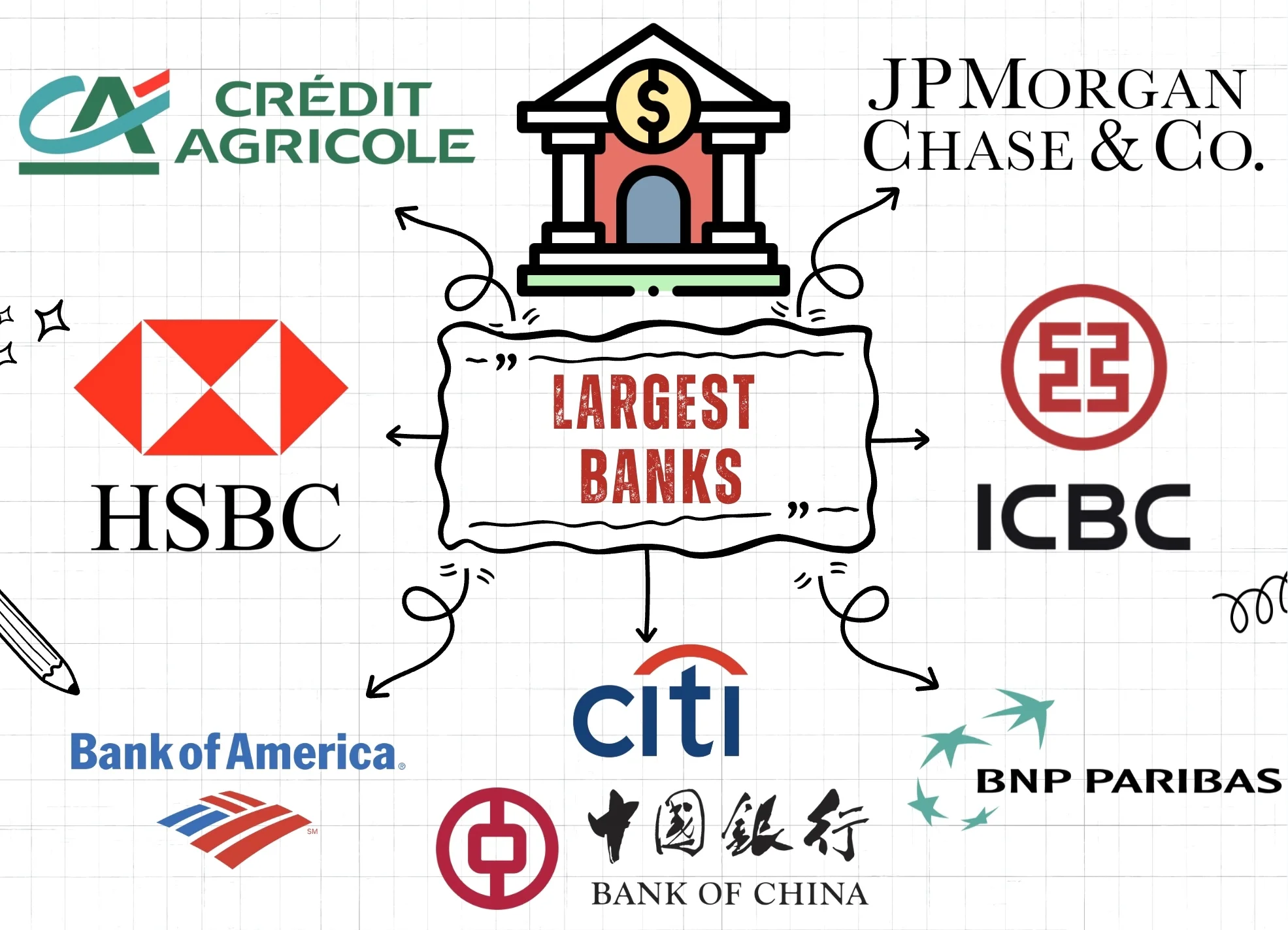
Table of Contents
18. Mizuho Financial Group – $1.8 trillion
Founded: 2000
Headquarters: Tokyo, Japan
Total Assets: $1.805 trillion
Ownership Type: Public
Number of Employees: 52,550+
Mizuho Financial Group, or simply Mizuho, is one of the three private megabanks in Japan alongside Mitsubishi UFJ and Sumitomo Mitsui Financial Group.
Mizuho was initially established as Mizuho Holdings in 2000 following the merger of three major Japanese banks. Until 2005, it remained the largest megabank in Japan and was surpassed only by other banking mergers in the country.
Today, Mizuho engages in a wide range of financial services, from banking and wealth management to private equity.
The group operates in three business divisions: Retail Group, which consists of its retail bank and venture capital firm; Mizuho Securities (investment bank); and Global Wealth and Asset Management.
During the subprime mortgage crisis of 2007, Mizuho’s New York operations lost close to $7 billion. It was the largest of any Asian bank during the crisis.
In 2025, Mizuho formed a strategic partnership with SoftBank Group to bring advanced AI technologies (including tools from OpenAI) into its internal operations and corporate client services. The bank expects this AI initiative to generate up to $2 billion in cost savings and additional revenue by fiscal 2030.
17. Barclays PLC – $1.9 trillion
Founded: 1690
Headquarters: London, United Kingdom
Total Assets: $1.900 trillion
Ownership Type: Public
Number of Employees: 93,000+
Barclays is one of the oldest continuously operating banks in the world. Its origin dates back to 1690. It is currently the second-largest bank in the UK, after HSBC. It has two core business divisions – Barclays U.K. and Barclays International.
In 2008, Barclays acquired most of Lehmann Brothers’ investment banking and trading operations in North America after the American firm filed for bankruptcy. The total value of the acquisition was $1.7 billion.
Barclays announced a strategic shift to allocate more capital to its higher-returning UK retail business while reducing the Investment Bank’s share of risk-weighted assets from about 63% in 2023 to around 50% by 2026. The bank also plans to enhance shareholder returns, aiming to distribute at least £10 billion between 2024 and 2026.
16. Banco Santander SA – $1.9 trillion
Founded: 1857
Headquarters: Boadilla del Monte, Spain
Total Assets: $1.901 trillion
Ownership Type: Public
Number of Employees: 206,700+
Banco Santander SA is Spain’s largest financial services company and the fourth-largest in Europe.
The bank is advancing its “ONE Transformation” program, which involves migrating legacy systems to global platforms such as its cloud-based core “Gravity” platform. In 2024, it also invested €166 million in initiatives focused on education, employability, entrepreneurship, and financial literacy — benefiting around 5 million people.
The bank has over 9,000 branches across Europe and the Americas. In Asia, the bank operates a total of four branches: two in China, one in Hong Kong, and one in Singapore. It serves more than 176 million customers.
15. Wells Fargo – $1.92 trillion
Founded: 1929
Headquarters: San Francisco, 30 Hudson Yards, and New York City
Total Assets: $1.929 trillion
Ownership Type: Public
Number of Employees: 217,000+
Wells Fargo is the fourth-largest financial services company in the United States and the fifteenth-largest in the world by total assets.
In 2015, Wells Fargo was the most valuable bank in the US, with the highest market cap and the third most assets. However, a major banking scandal in 2016 caused the bank to lose its reputation among investors, ultimately affecting its market cap.
In 2018, the US Federal Reserve instructed Wells Fargo that it couldn’t increase its assets beyond $1.95 trillion until it made the necessary changes to its operations. This hampered the bank’s ability to expand into various profitable businesses.
Although the bank is still suffering from the repercussions of its earlier misconduct, it has managed to maintain its position as one of the largest banks in the world.
Wells Fargo offers retail and corporate banking, wealth management, and investment banking services. It operates over 4,177 branches and 13,000 ATMs nationwide.
In 2022, Wells Fargo was the fourth-largest mortgage lender in the country by the total number of loans and the third-largest by loan value ($79 billion).
In recent years, the bank has shown modest revenue growth and strong improvements in credit quality, thereby improving profitability and reducing risk. The improved Return on Tangible Common Equity (ROTCE) signals better capital utilisation and may reflect management’s focus on returns.
14. Sumitomo Mitsui Financial Group – $1.97 trillion
Founded: 2002
Headquarters: Tokyo, Japan
Total Assets: $1.977 trillion
Ownership Type: Public
Number of Employees: 123,000+
Sumitomo Mitsui Financial Group, or SMFG, is Japan’s second-largest financial holding company by total assets and market cap.
The group conducts its business operations under a subsidiary entity called Sumitomo Mitsui Banking Corporation Group or SMBC Group. The SMBC Group has multiple subsidiaries of its own, with its banking unit (SMBC) being the largest among them.
Sumitomo Mitsui Banking Corporation was established in 2001 after the mega-merger of two prominent Japanese banks: Sakura Bank and the Sumitomo Bank.
However, even after the merger, the new entity continued to suffer from asset quality problems (bad loans or non-performing loans) caused by the Japanese asset price bubble collapse in 1991.
The entire banking industry of Japan suffered from bad debt and stagnant credit growth throughout the 1990s.
However, by leveraging its size and several corporate actions, SMBC Group was able to expand its assets significantly by the end of 2019.
Today, the bank has offices and branches in over 40 countries worldwide and offers a wide range of financial services to individuals, small and medium-sized enterprises, large corporations, financial institutions, and public sector entities.
In recent years, SMBC has increased its efforts to offer digital asset services to its clients. In 2022, it entered a partnership with HashPort, a blockchain startup, to work on NFT and other blockchain services.
In 2025, SMBC increased its stake in US investment bank Jefferies Financial Group to 20%. As part of the deal, the two companies will also create a joint venture in Japan focused on wholesale equities (including equity capital markets, research, and sales and trading), scheduled to launch in 2027.
13. Bank of Communications – $2 trillion
 Bank of Communications in Zhengzhou
Bank of Communications in Zhengzhou
Founded: 1908
Headquarters: Shanghai, China
Total Assets: $2.041 trillion
Ownership Type: Public, State-owned entity
Number of Employees: 95,700+
The Bank of Communications (BoComm) is the sixth-largest commercial bank in China. It’s one of the country’s most important financial institutions, offering services such as insurance, fund management, securities, and offshore financial services.
The bank was originally established in 1908 by the government to buy out an important railway line connecting Beijing. In 1986, BoComm underwent a restructuring and was relaunched as a modern bank the following year.
Today, the Bank of Communications operates in over 80 countries through subsidiaries and representative offices.
According to The Banker, a British banking and finance journal, the Bank of Communications is among the top 50 best-performing banks in the world. The bank is ranked 155th on the Forbes Global 500 list.
12. Citigroup Inc. – $2.1 trillion
Founded: 1998
Headquarters: New York City, USA
Total Assets: $2.151 trillion
Ownership Type: Public
Number of Employees: 229,000+
Citigroup is the third-largest bank in the US, behind JPMorgan Chase and Bank of America. These three banks, along with Wells Fargo, are recognized as the “big four” banks that hold over 40 percent of all customer deposits in the country.
It is also one of the nine bulge bracket banks – a group of the world’s largest investment banks.
Citigroup has five core interconnected business divisions:
- Retail banking and branded cards,
- Commercial banking and advisory,
- Global wealth management,
- Investment banking, and
- Treasury and Securities Services
Citigroup operates its retail banking and card services through Citibank, which has a global network of more than 4,600 branches. It offers credit card services in over 90 countries.
The company also owns and operates banking subsidiaries in other countries, including Citibanamex (the second largest bank in Mexico) and Citi Handlowy in Poland.
Through its services like Citigold and Citi Private Bank, Citigroup offers exclusive financial services to wealthy and high-net-worth clients. It competes with firms like Goldman Sachs and UBS in the wealth management industry.
Furthermore, Citigroup is the fourth-largest M&A advisory firm by total deal value and the fifth-largest custodian bank in the world, with about $13 trillion in assets under custody.
11. Postal Savings Bank of China – $2.34 trillion
Founded: 2007
Headquarters: Beijing, China
Total Assets: $2.341 trillion
Ownership Type: Public
Number of Employees: 182,600+
Postal Savings Bank of China, or PSBC, was established in 2007 by the People’s Republic of China government to provide basic banking services to people who otherwise do not have access to them.
PSBC was initially backed by the State Post Bureau (the postal service agency of China), but in 2015, the bank received investments from a pool of national and foreign financial institutions, including the International Finance Corporation, Morgan Stanley, Temasek Holdings, Tencent, China Life (China’s largest life insurer), and Ant Financial Services Group.
Its products are mostly geared toward the financial needs of rural, low-income customers and various SMEs (microfinance). For example, its “One County, One Product (OCOP)” programme supports county-level specialty industries by providing loans, data analytics, brand-building support, and access to e-commerce.
The bank has implemented OCOP in over 1,000 counties and issued more than $84 billion in related loans.
Due to its extensive reach in rural areas, PSBC allows the government to implement its various microcredit schemes and economic stimulus more efficiently than any other bank in the country. As of 2025, it had over institutions, including a head office, branches, and sub-branches.
10. Mitsubishi UFJ Financial Group – $2.6 trillion
Founded: 2005
Headquarters: Tokyo, Japan
Total Assets: $2.628 trillion
Ownership Type: Public
Number of Employees: 150,800+
With total assets close to $2.6 trillion, the Mitsubishi UFJ Financial Group (MUFG) is the tenth-largest financial services company in the world and the largest in Japan.
MUFG is part of the Mitsubishi Group, the second-largest conglomerate in Japan. Like the other two Japanese mega banks, MUFG was created in 2005 following the merger of the Bank of Tokyo-Mitsubishi and UFJ Bank, a subsidiary of UFJ Holdings.
The Mitsubishi UFJ Financial Group conducts most of its banking operations in Japan and other countries through its main subsidiary, MUFG Bank (formerly known as BTMU).
MUFG is the largest shareholder of US-based Morgan Stanley, one of the biggest investment banks in the world.
In 2008, amidst the financial crisis, MUFG acquired a 21 percent stake in Morgan Stanley for about $9 billion in an all-cash deal. The investment was critical for the survival of the American investment bank.
MUFG is accelerating its AI and data infrastructure while strengthening its digital business model. In 2025, it partnered with Sakana AI to deploy the company’s technologies for document automation and other high-value internal processes.
The Group is also advancing its “Social & Environmental Progress” goals under its strategic plan. In 2025, MUFG and its subsidiary MUFG Bank created a “Sustainable Finance Framework” in collaboration with the Japan International Cooperation Agency (JICA) and regional partner banks in Southeast Asia. The framework supports green, social, and sustainability-focused loans.
9. Crédit Agricole Group – $2.6 trillion
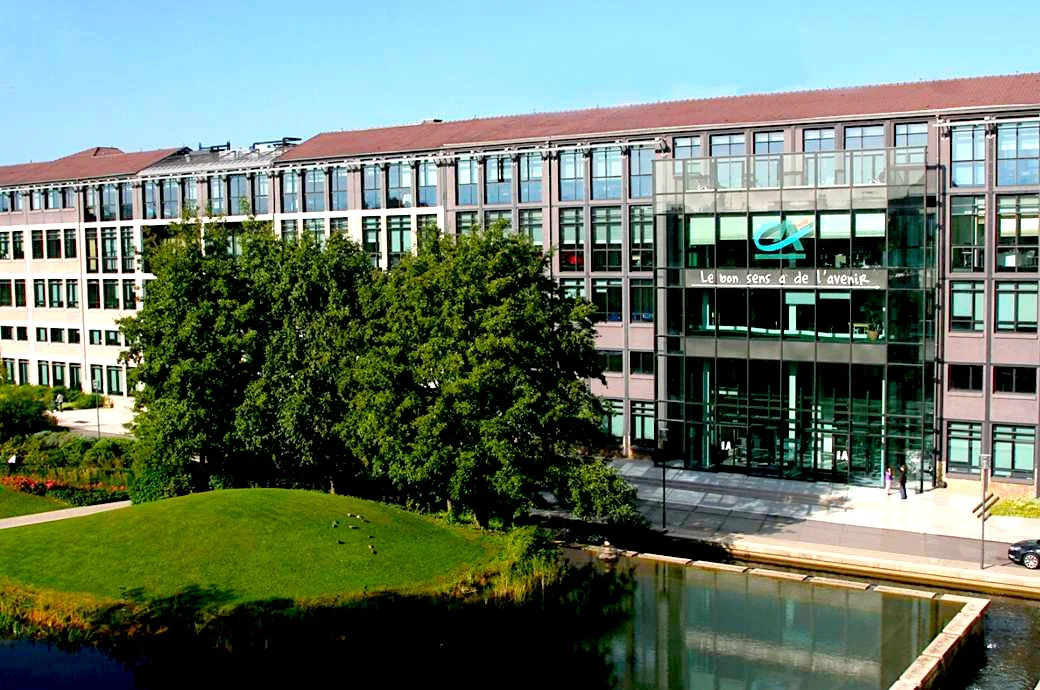 Crédit Agricole SA. headquarters in Montrouge, France
Crédit Agricole SA. headquarters in Montrouge, France
Founded: 1998
Headquarters: Paris, France
Total Assets: $2.693 trillion
Ownership Type: Public
Number of Employees: 157,000+
With total assets exceeding $2.69 trillion, Crédit Agricole is the largest cooperative bank and mutualist financial institution in the world. It is the second-largest banking institution in France and the third-largest in Europe by total assets.
The group consists of a network of local and regional banks that provide various financial services to individual customers and corporate entities.
These local and regional banks are controlled by Crédit Agricole S.A., which acts as a centralized body for the company.
Crédit Agricole has a long and illustrious history and played a key role in the economic growth of France. The bank was established in the late 1880s by the government to provide necessary financial services to farmers and support agricultural activities throughout the country.
In 1988, Crédit Agricole underwent major institutional changes, after which it became a fully privately owned company. Since then, it has made several acquisitions to diversify into other businesses and expand internationally.
Besides consumer banking services, Crédit Agricole currently provides wealth and asset management, private banking, and investment banking services directly or through a subsidiary.
Crédit Agricole is the majority owner of Amundi, one of the world’s largest asset management companies. It has also increased its stake in Banco BPM (Italy’s third-largest lender) to ~20.1%, increasing its cross-border presence.
8. BNP Paribas – $2.8 trillion
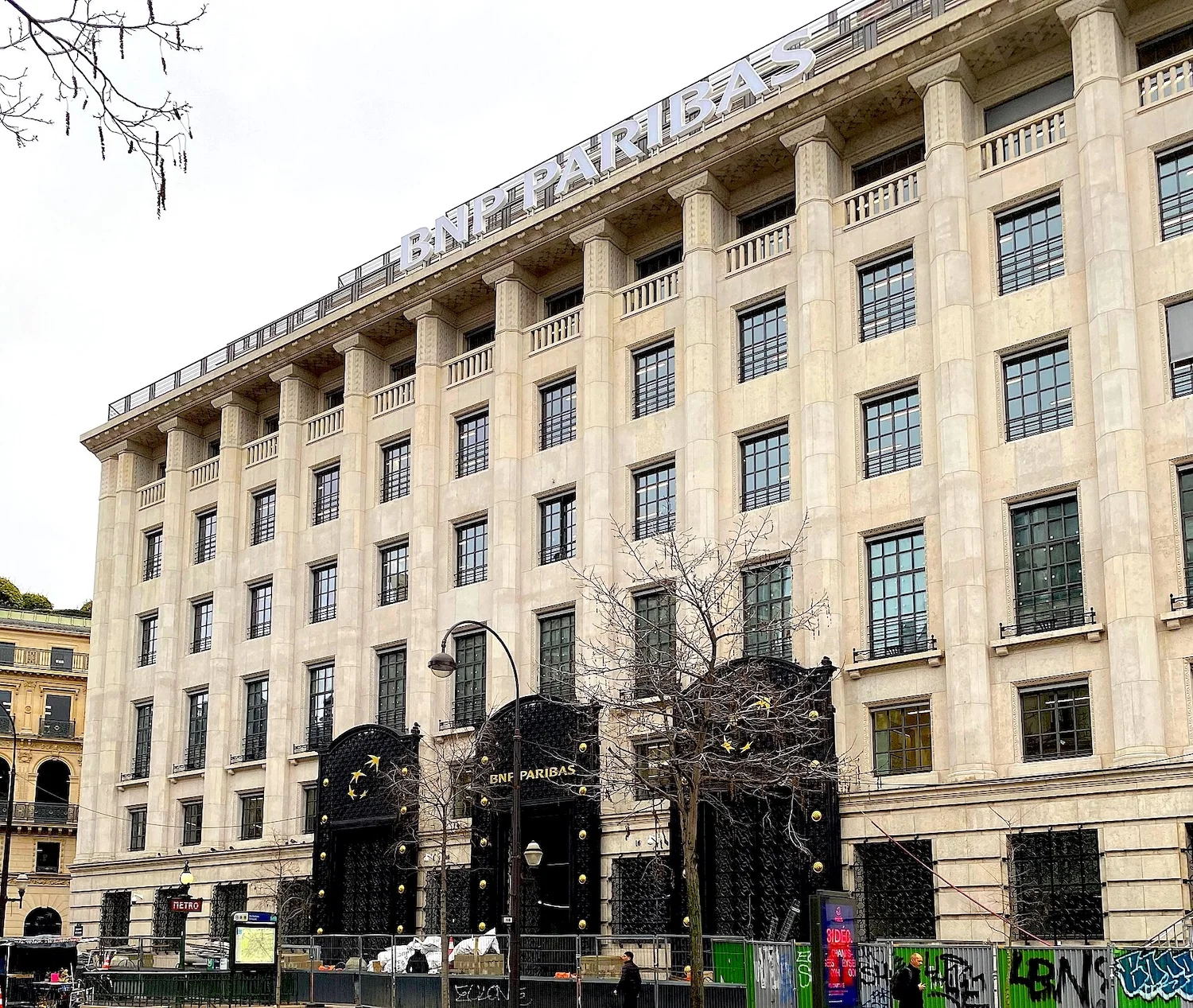 Head office of BNP Paribas in Paris
Head office of BNP Paribas in Paris
Founded: 2000
Headquarters: Paris, France
Total Assets: $2.693 trillion
Ownership Type: Public
Number of Employees: 178,000+
BNP Paribas is the second-largest financial institution in Europe in terms of both assets under management and market cap. It is the largest bank in France.
BNP Paribas offers a wide variety of financial services, including insurance, in about 64 countries worldwide, either directly or through a subsidiary.
The bank has three core divisions;
- Commercial, Personal Banking & Services (CPBS)
- Investment & Protection Services (IPS), and
- Corporate & Institutional Banking (CIB)
The company owns and operates several banking subsidiaries in other countries. Including Bank of the West in the U.S., Banca Nazionale del Lavoro (BNL) in Italy, and a digital-only bank called Hello Bank!
Like many large banking groups, BNP Paribas was established following a merger between Banque Nationale de Paris (BNP) and Paribas in 2000.
In August 2007, BNP Paribas became the first major banking institution to raise the alarm on the subprime crisis as it closed two of its funds exposed to subprime-backed securities.
This timely action not only helped the bank avoid a lot of damage but also turned out to be a blessing for its investment banking business.
The earnings for BNP Paribas CIB (investment banking arm) have doubled since 2009, mainly because its M&A advisory and derivatives businesses are growing rapidly.
BNP is making major investments in digital and AI. For example, it has launched an internal “LLM as a Service” platform to speed up the use of generative AI across its businesses.
On the sustainability front, BNP signed an agreement with the European Investment Bank (EIB) to provide €1 billion in guarantees for EU wind energy projects, which may mobilise ~€8 billion total investment.
7. HSBC Holdings – $2.9 trillion
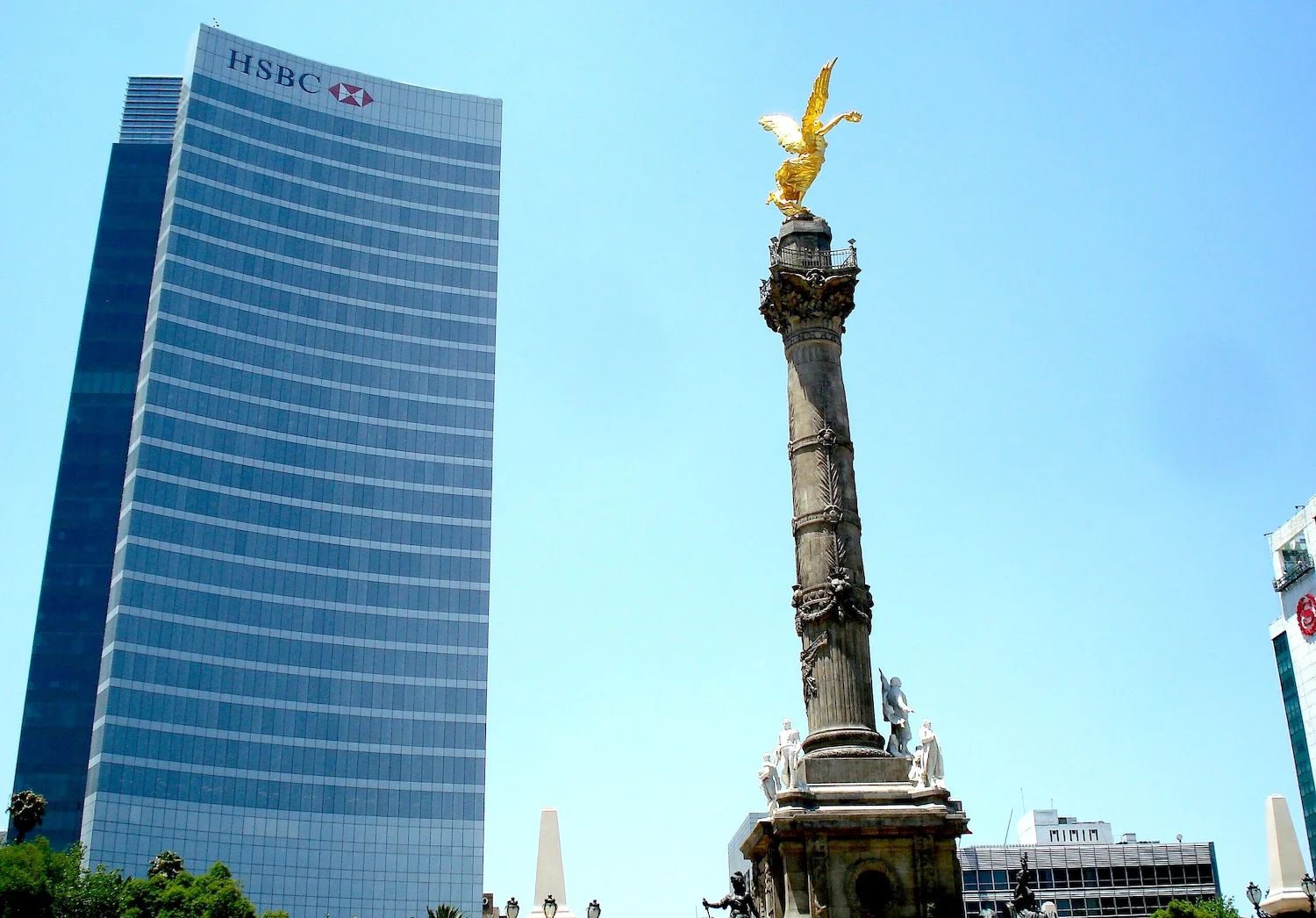 HSBC Tower in Mexico City
HSBC Tower in Mexico City
Founded: 1991
Headquarters: London, United Kingdom
Total Assets: $2.989 trillion
Ownership Type: Public
Number of Employees: 221,000+
The British banking behemoth HSBC is perhaps one of the most recognizable names in the financial industry. It is currently the largest financial institution in Europe and the eighth largest globally.
HSBC has a unique business connection with Asia, unlike any other large Western bank. The bank was actually founded in Hong Kong as The Hong Kong and Shanghai Banking Corporation in 1865 by British banker Thomas Sutherland.
The primary objective of this bank was to finance the trading activities of British merchants in China and India.
It was not until 1993 that the bank relocated its global headquarters from Hong Kong to London. One of the biggest reasons behind this relocation was the impending handover of Hong Kong to China in 1997.
About half of HSBC’s annual revenue comes from the Asia-Pacific region, and the bank is doubling down on that market. One major step in this direction is its $13.6 billion all-cash bid to acquire full ownership of Hang Seng Bank. HSBC already owns roughly 63% of the bank.
HSBC has three core business divisions –
- Wealth and personal banking (retail banking)
- Commercial banking
- Global banking and markets
HSBC operates branches and offices in 64 countries across the globe and serves around 41 million customers.
6. Bank of America – $3.2 trillion
Founded: 1998
Headquarters: California and New York City
Total Assets: $3.261 trillion
Ownership Type: Public
Number of Employees: 213,000+
Bank of America (BOFA) is the second-largest bank in the United States after JPMorgan. Out of the top six US banks, BOFA and Wells Fargo are the only two banking institutions with headquarters outside of New York.
The bank was founded in 1923 in Los Angeles, but in 1928 it was acquired by the Bank of Italy. Shortly after, the combined entity changed its name back to Bank of America to gain broader recognition.
The Bank of America of today is a result of numerous acquisitions and mergers of financial institutions by the company.
Some of the most prominent acquisitions by the Bank of America include Security Pacific Corporation in 1992, Continental Illinois National Bank in 1994, and Merrill Lynch & Co. in 2008.
BofA’s consumer banking arm, which provides loans, credit cards, and other banking services to individual customers, is accountable for about one-third of its total revenue.
It also has a substantial presence in the wealth and investment banking industry. Bank of America’s Global Wealth and Investment Management division, which includes Merrill Lynch and Bank of America Private Bank, is the third-largest in the world in terms of AUM.
In 2025, the bank spent nearly $4 billion on AI and new technology initiatives (almost one-third of its total tech budget). Over 90% of employees now use its internal AI virtual assistant, Erica for Employees, to boost productivity across areas like operations, IT support, and client-facing work.
BofA plans to open more than 150 new financial centers by the end of 2027 in ~60 markets, including a flagship center in New York City at 2 Bryant Park, and its first location in the Boise (Idaho) area.
Did you know?
Bank of America was one of the major banks that issued a significant amount of mortgage-backed securities before 2008, which eventually led to financial calamity.
5. JPMorgan Chase – $4 trillion
Discover how data centers, fiber, and towers are powering the digital economy.
J.P. Morgan’s Scott Wilcoxen and Fahmi Enam discuss the capital needs for AI and cloud, industry challenges, and how the firm supports clients in digital infrastructure. https://t.co/qb4ovH0eOh pic.twitter.com/ZDEPKZJLcX
— J.P. Morgan (@jpmorgan) September 26, 2025
Founded: 2000
Headquarters: New York City, USA
Total Assets: $4.002 trillion
Ownership Type: Public
Number of Employees: 317,230+
JPMorgan Chase remains one of the most recognized and valuable banking brands in the world. It is the largest bank in the world by market cap and the fifth-largest by total assets. JPMorgan Chase is the largest of the Big Four banks in the U.S.
The firm, as we know it today, is the result of a series of mergers among leading US banks. It includes J.P. Morgan & Co., Chase Manhattan Bank, and Bank One Corporation.
The earliest origin of the bank can be traced back to the establishment of the Bank of Manhattan Company in 1799. It was merged with Chase National Bank in 1955 to create Chase Manhattan Bank. Then, in 2000, Chase merged with JPMogan & Co. (founded in 1871) to form JPMorgan Chase.
Today, JPMorgan Chase provides its retail banking and credit card services under the brand name ‘Chase’.
Meanwhile, corporate banking services like asset management, private wealth management, and security services are carried under the brand name of J.P. Morgan.
JPMorgan Chase drew major attention in 2023 when it acquired most of the assets and deposits of First Republic Bank after its collapse. Before failing, First Republic was the 19th largest bank in the United States by total assets.
In 2025, JPMorgan launched a 10-year, $1.5 trillion “Security & Resiliency Initiative” to finance industries considered vital to U.S. national security and economic strength, including defense, energy independence, manufacturing, and advanced technologies.
4. Bank of China – $4.8 trillion
 Bank of China Headquarters in Beijing
Bank of China Headquarters in Beijing
Founded: 1905
Headquarters: Beijing, China
Total Assets: $4.803 trillion
Ownership Type: Public; State-owned
Number of Employees: 312,750+
The Bank of China (BOC) is the fourth-largest financial institution in the world by total assets. It is the biggest loan provider for individual customers and the second biggest lender overall.
The bank was established in 1905 as Daqing Hubu Bank (later Daqing Bank).
After the Chinese Civil War ended in 1949, the Daqing Habu was split into two: Taiwan operations, which later became the Mega International Commercial Bank, and Mainland China operations, which became known as the Bank of China.
BOC provides a wide range of financial services, from savings, credit cards, mortgages, and insurance to wealth management and investment banking. It is almost entirely owned by the Government of China.
The Bank of China has a massive presence internationally, with branches in about 27 countries, including Zambia and South Africa.
BOC has two major subsidiaries: one that operates in Hong Kong (BOC Hong Kong) and one in Bank of China in Canada. The Bank of China Hong Kong is currently the second-largest commercial bank in Hong Kong.
The bank continues to expand international operations: it has 15 overseas institutions serving as RMB clearing banks and 39 institutions connected to the Cross-border Interbank Payment System (CIPS).
3. China Construction Bank Corporation – $5.5 trillion
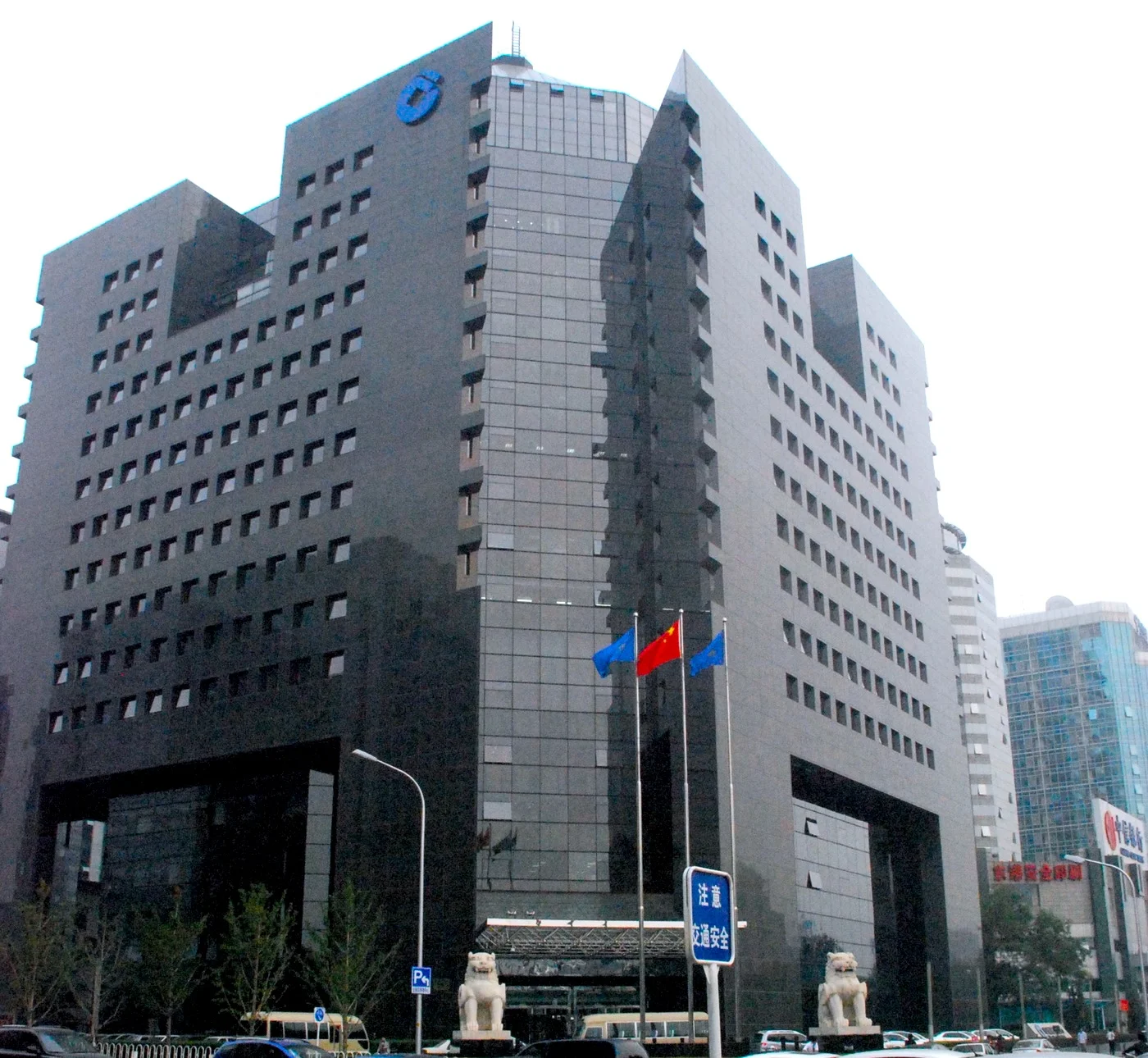 China Construction Bank Building
China Construction Bank Building
Founded: 1954
Headquarters: Beijing, China
Total Assets: $5.558 trillion
Ownership Type: Public, Government of China
Number of Employees: 454,700+
China Construction Bank Corporation (CCB) is the third-largest banking institution in China and the world. It is also one of the ten biggest public companies in the world.
Headquartered in Beijing, CCB has over 13,600 domestic branches and more than a dozen international ones, including a wholly-owned subsidiary in London.
Like any other global bank, it offers retail banking services like mortgages, credit cards, and personal loans to the general public and investment banking solutions to big corporations. CCB is also engaged in private equity and wealth management business.
To tap into China’s rapidly growing banking sector, Bank of America purchased a 9% stake in China Construction Bank for $3 billion in 2005, followed by another 1.75% in 2008. However, between 2011 and 2013, BofA sold its entire stake for a total of $9.8 billion.
CCB is actively shifting its focus toward higher-value growth sectors such as private and tech enterprises, the digital economy, green finance, and rural/inclusive finance — all in line with China’s national policy priorities.
In 2025, the bank pledged to provide at least RMB 8 trillion (about US$1.1 trillion) in financing for the private economy by the end of 2027. It also launched its internal large financial AI model, “DeepSeek-R1,” marking a major step in its adoption of advanced technology and AI-driven solutions.
2. Agricultural Bank of China – $5.9 trillion
Founded: 1951
Headquarters: Beijing, China
Total Assets: $5.923 trillion
Ownership Type: Public
Number of Employees: 454,700+
The Agricultural Bank of China (AgBank) is the second-largest bank in both China and the world. It was originally founded in 1951 through the merger of the Farmers Bank of China and the Cooperative Bank. After several restructurings, AgBank took its current form in 1979.
In 2010, AgBank launched what was then the world’s largest IPO, a record later surpassed by Alibaba.
Apart from retail and investment banking, the Agricultural Bank of China is engaged in global wealth management and private equity.
In 2007, the bank was subject to massive embezzlement worth ¥51 million (or US$6.7 million), perpetrated by the vault managers of one of its branches. It remains the largest bank robbery in Chinese history to date.
The bank has a particularly strong presence in “county areas,” referring to rural and lower-tier cities. In FY 2025, its loans and advances in these regions reached RMB 9.85 trillion, with more than RMB 1 trillion tied to grain and major agricultural products. The bank continues to focus on supporting rural revitalization, food security, and the agricultural sector, serving farmers and rural communities.
Today, AgBank has about 24 thousand branches nationwide, over 420 million general customers, and 3 million institutional clients. It also has 172 million monthly active retail mobile banking users.
1. Industrial and Commercial Bank of China – $6.6 trillion
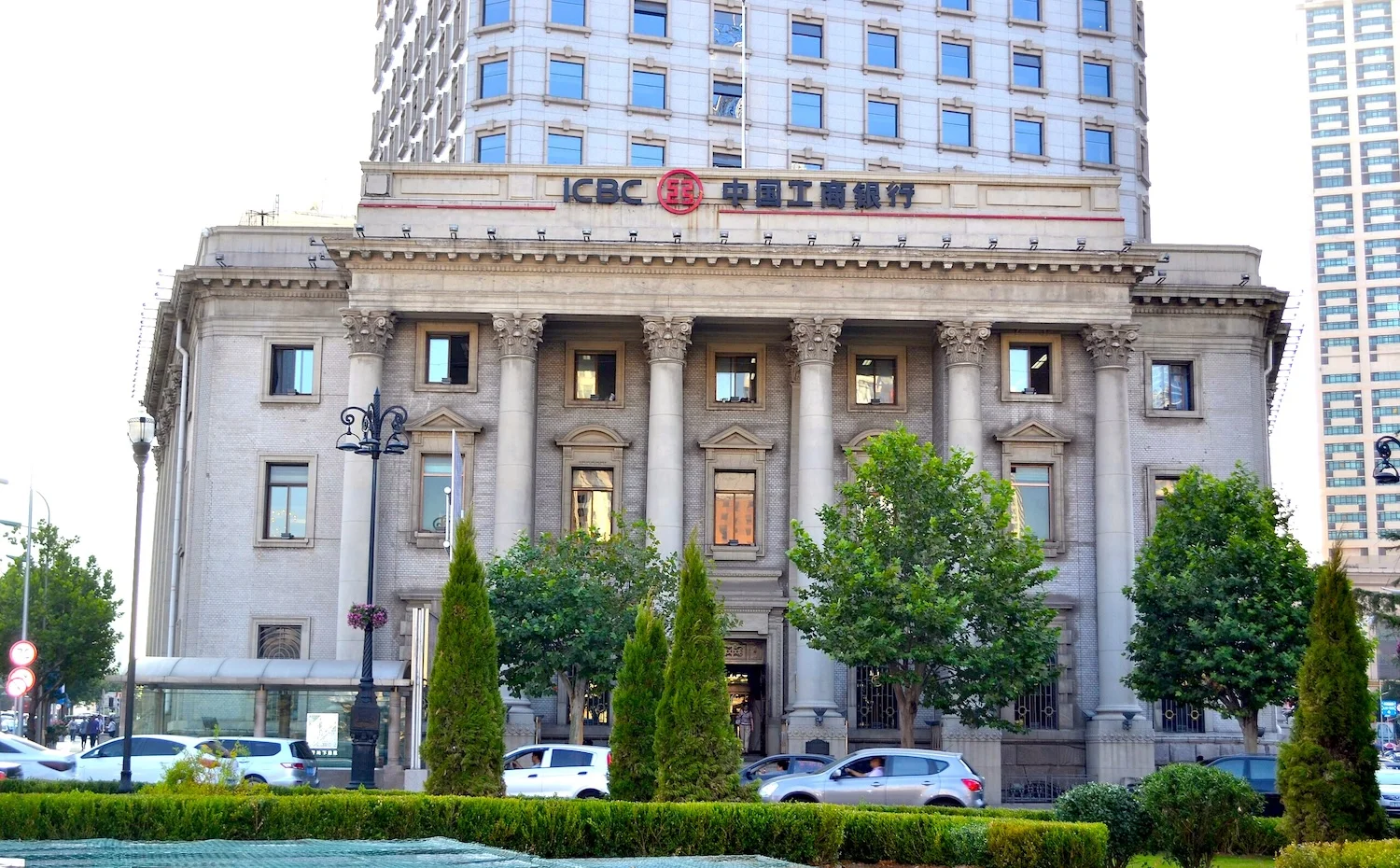 ICBC branch in Dalian
ICBC branch in Dalian
Founded: 1954
Headquarters: Beijing, China
Total Assets: $6.688 trillion
Ownership Type: Public, State-owned
Number of Employees: 454,700+
With over $6.6 trillion in total assets, the Industrial and Commercial Bank of China (ICBC) is by far the largest bank in the world.
Like China’s other major state-owned banks, ICBC is primarily government-owned. Because of its vast size, the bank plays a significant role in shaping China’s economy.
The bank operates a massive network of 17,000 domestic and 400 international branches, the most of any bank in the world. It serves about 750 million individual customers and 13 million corporate clients.
It offers a wide range of financial services, including consumer and corporate banking, investment management, private equity, and credit cards.
In 2022, the Industrial and Commercial Bank of China was the seventh most profitable company and the most profitable bank globally. Furthermore, it was ranked 2nd on the Forbes Global 2000 list of the largest public companies.
In 2024, ICBC’s mobile banking app reached around 588 million personal users, including over 260 million monthly active users. The bank also introduced its enterprise-level financial large model, “ICBC Zhiyong,” which features hundreds of billions of parameters and supports about 200 business scenarios across 20 major areas.
In FY 2025, ICBC reported $219.3 billion in revenue and $112.5 billion in gross profit. The bank also announced plans to issue a multi-currency, carbon-neutral green bond through its branches in Hong Kong, Singapore, and Dubai.
More to Know
What criteria are used to determine the total assets of a bank?
The total assets are a crucial measure for evaluating a bank’s size and financial health. It encompasses various financial elements, including cash, loans, accrued interest, investments in government and corporate bonds, physical assets like land and buildings, and reserves and deposits held with other banks.
Common risks Large banks face
Large financial institutions, due to their size and systemic importance, face multiple risks that can significantly impact their financial stability and operational efficiency. The major risks include:
- Systemic risk: arises when the failure of one large bank triggers a domino effect, impacting other financial institutions
- Credit risk: arises when borrowers fail to repay their loans
- Market risk: arises from fluctuations in interest rates, commodity prices, currency exchange rates, and equity markets
- Liquidity risk: arises when a bank cannot easily convert its assets into cash to cover liabilities
- Cybersecurity threats like data breaches or ransomware attacks lead to financial losses and reputational damage
- Geopolitical and macroeconomic risk: arises due to major changes in government policies, trade agreements, or economic downturns in key regions.
Trends shaping the future of the banking industry
The banking industry is undergoing major changes driven by digitalization, including integrating fintech, using AI and machine learning to automate tasks, and adopting blockchain and distributed ledger technology for greater transparency and security.
Biometric authentication techniques, such as facial and voice recognition, are also becoming more prevalent to enhance security in online and mobile banking.
Plus, there is a growing emphasis on sustainable and socially responsible banking practices. Big financial institutions are incorporating ESG (environmental, social, and governance) criteria into their decision-making processes.
Read More

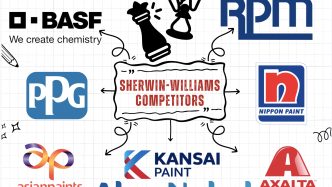

The total assets listed for Wells Fargo bank is incorrectly written as US$ 1.951 billion. I think, it should be corrected to US$1,951 billion.